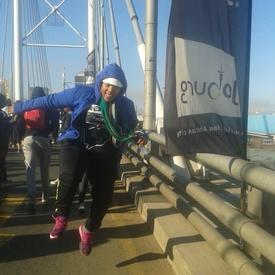Polar HRM calorie burn estimate accuracy - study

heybales
Posts: 18,842 Member
Just in case the ladies are thinking that even the HRM calorie estimate may be off, you are probably not wrong.
This is a study on a specific model, but chances are Polar has not refined their calculations much on other models that ask for the same info.
Guys, we got it lucky.
http://www.ux1.eiu.edu/~cfje/5700/PolarWatch-study-MSSE.pdf
In conclusion, when the predicted values of V˙ O2max and HRmax are used, the Polar S410 HRM provides a rough estimate of EE during treadmill, cycling, and rowing. For males, the use of predicted values resulted in a mean error of 2% (SD 18%), whereas in females the mean error was 33% (SD 20.9). To improve on the accuracy, the actual measured values forV˙ O2max and HRmax should be used. For males, this resulted in a 4% error (SD 10%), whereas in females the mean error was improved to 12% (SD 13%). In addition, the Polar S410 has an important advantage over motion sensors in that it is applicable to a variety of exercise modes.
And an interesting comment regarding the BodyBugg / BodyMedia / FitBit style of calorie estimation.
Previously, Levine et al. (17) have shown that by using accelerometers and inclinometers to capture body motion and position, they can account for 85% of nonexercise activity thermogenesis (NEAT). NEAT is comprised of several components such as occupational work, walking, sitting, standing, and any other nonexercise movement performed throughout the day. Thus, a person could wear the motion and position sensors throughout the day and remove them and put on the HR monitor when performing structured exercise.
This is a study on a specific model, but chances are Polar has not refined their calculations much on other models that ask for the same info.
Guys, we got it lucky.
http://www.ux1.eiu.edu/~cfje/5700/PolarWatch-study-MSSE.pdf
In conclusion, when the predicted values of V˙ O2max and HRmax are used, the Polar S410 HRM provides a rough estimate of EE during treadmill, cycling, and rowing. For males, the use of predicted values resulted in a mean error of 2% (SD 18%), whereas in females the mean error was 33% (SD 20.9). To improve on the accuracy, the actual measured values forV˙ O2max and HRmax should be used. For males, this resulted in a 4% error (SD 10%), whereas in females the mean error was improved to 12% (SD 13%). In addition, the Polar S410 has an important advantage over motion sensors in that it is applicable to a variety of exercise modes.
And an interesting comment regarding the BodyBugg / BodyMedia / FitBit style of calorie estimation.
Previously, Levine et al. (17) have shown that by using accelerometers and inclinometers to capture body motion and position, they can account for 85% of nonexercise activity thermogenesis (NEAT). NEAT is comprised of several components such as occupational work, walking, sitting, standing, and any other nonexercise movement performed throughout the day. Thus, a person could wear the motion and position sensors throughout the day and remove them and put on the HR monitor when performing structured exercise.
0
Replies
-
Thanks...just got a Polar HRM but have not used it yet.0
-
Personally I don't care if mine is off, just having one in itself, seeing the results makes me WANT to workout more. It makes me want to get more exercise in to see the numbers go up. Ever since I got it I've been in love with it :P Interesting study I guess, mine's an FT60 so I would assume it's a least a little more accurate either way I'm happy, was $130 or whatever it cost well spent imo
 0
0 -
Here's a big bump for further study!0
-
So in layman's terms, my FT7 is giving me the wrong results in terms of calories burnt?
That's disappointing.0 -
Whether it is off or not, I don't know. But I use a Polar FT60 and the Body Media FIT and have to say that both are very close to each other after nearly every workout I've done - whether that is walking, treadmill, elliptical, spinning.0
-
I guess I should have thrown the solution in there to obtain the better accuracy. Though you still may want to subtract 12%.
It's the default calculations based on avg's that cause the biggest inaccuracy.
If you can find out your own figures for max HR, and if your monitor lets you do it, VO2 max, you can greatly improve the accuracy.
For VO2 max estimate:
http://www.brianmac.co.uk/queens.htm
Here is a submaximal test to estimate your max HR, if you feel like doing the true killer test (and serious, be fit already to do that one), you can find it at the above site.
. The SubMax Step Test. Use an 8" step (almost any step in your home or in a club will do) and perform a 3-minute step test. After your warm-up, step up and down in a four-count sequence as follows: right foot up, left up, right down, left down. Each time you move a foot up or down, it counts as one step.
Count "up, up, down, down" for one set, with 20 sets to the minute. It is very important that you don't speed up the pace--keep it regular. After 2 minutes, you'll need to monitor your heart rate for the last minute. The SubMax Step Test now can be used to predict your Max HR. Add to your last minute's heart rate average one of the following numbers:
1. Poor Shape: +55 bpm
2. Average Shape: +65 bpm
3. Excellent Shape: +75 bpm
Your result should be pretty close to your Max HR. (last-minute heart rate average might be something like 120 bpm, to which I'd add 75 bpm, bringing the total to 195 bpm.)0 -
So in layman's terms, my FT7 is giving me the wrong results in terms of calories burnt?
That's disappointing.
How accurate is your calories you're supposed to consume?? That's probably inaccurate too. Everything comes with inaccuracies. So don't worry about it.
Well this is depressing.0 -
So in layman's terms, my FT7 is giving me the wrong results in terms of calories burnt?
That's disappointing.
Well, just a little over-estimated hopefully. Might be up to 165 cal when it tells you 500 cal burned.
But since the deviation for the women was 21%, you could be all over the place actually.
But since you have reached goal weight, and you are now training for that marathon/triathlon, you'll get into the zone training aspect anyway, right?!
Just do one of the real Max HR tests since you are in shape already and really improve your odds.0 -
Bump0
-
So in layman's terms, my FT7 is giving me the wrong results in terms of calories burnt?
That's disappointing.
How accurate is your calories you're supposed to consume?? That's probably inaccurate too. Everything comes with inaccuracies. So don't worry about it.
Well this is depressing.
Lol, true. And I've lost 2.5 kg since having my HRM so I'm not complaining!
and thanks for the test OP I might have to give that a try once I think I have the energy0 -
since my polar HRM asked for my age, weight and stuff, should I clear that? to get better accuracy cause my TIMEX never asked for it. What should i do?0
-
since my polar HRM asked for my age, weight and stuff, should I clear that? to get better accuracy cause my TIMEX never asked for it. What should i do?
No you shouldn't clear it.... It needs that info to give a calorie estimation.
Timex HRM's are crap at estimating calories.. so you are way better off with the Polar anyway.0 -
since my polar HRM asked for my age, weight and stuff, should I clear that? to get better accuracy cause my TIMEX never asked for it. What should i do?
No you shouldn't clear it.... It needs that info to give a calorie estimation.
Timex HRM's are crap at estimating calories.. so you are way better off with the Polar anyway.
Ditto's, I recorded many sessions from the Timex, which only asked for weight and MHR, and I am doubting it really used the MHR in calculations, as it is an optional entry. I think it just set the zones off that stat.
The Timex showed at every AHR to be about 50% more than the Polar, correctly set with gender, age, weight, and manual MHR correction (but no VO2max which study above says is pretty good anyway for men).0 -
Even more depressing.So in layman's terms, my FT7 is giving me the wrong results in terms of calories burnt?
That's disappointing.
Well, just a little over-estimated hopefully. Might be up to 165 cal when it tells you 500 cal burned.
But since the deviation for the women was 21%, you could be all over the place actually.
But since you have reached goal weight, and you are now training for that marathon/triathlon, you'll get into the zone training aspect anyway, right?!
Just do one of the real Max HR tests since you are in shape already and really improve your odds.0 -
since my polar HRM asked for my age, weight and stuff, should I clear that? to get better accuracy cause my TIMEX never asked for it. What should i do?
No you shouldn't clear it.... It needs that info to give a calorie estimation.
Timex HRM's are crap at estimating calories.. so you are way better off with the Polar anyway.
Ditto's, I recorded many sessions from the Timex, which only asked for weight and MHR, and I am doubting it really used the MHR in calculations, as it is an optional entry. I think it just set the zones off that stat.
The Timex showed at every AHR to be about 50% more than the Polar, correctly set with gender, age, weight, and manual MHR correction (but no VO2max which study above says is pretty good anyway for men).
I have a Timex and I confirm, it's crap.
I'm going to buy a Polar. Even if it's not 100% accurate, it will be closer.
Thanks for this interesting post.0 -
bump0
-
bump0
-
bumpity0
-
Bump for when I get my Polar FT4 this weekend
 0
0 -
bump0
-
bump0
-
Whether it is off or not, I don't know. But I use a Polar FT60 and the Body Media FIT and have to say that both are very close to each other after nearly every workout I've done - whether that is walking, treadmill, elliptical, spinning.
I have this one to and I love it!0 -
bump0
-
I have a polar F11 and a garmin, the garmin gives about half the calorie burnt on the polar. I just use polar in the gym and garmin outside and at the end ot the day it is the weight lost that counts and I just use the HRM to push me to work harder.0
-
Sois the inaccuracy in additional burn calculations or reduced burn calculations?????
Regardelss, as long are you are benchmarking constantly to the same scale does it matter??? The issue would be if you used varied scales and compared them...0 -
Now this has got me thinking...I have a tunturi C85 elliptical which comes with a heart rate strap. I was thinking that the calorie burn was low for the effort i was putting in so i put on my fitbit and my polar ft7.
The fitbit gave me slightly under double the burn of the tunturi strap, while the HRM gave me approx 38% more than the Tunturi.
Question is now...Which do i actually trust when i`m eating back cals?????0 -
I have a polar F11 and a garmin, the garmin gives about half the calorie burnt on the polar. I just use polar in the gym and garmin outside and at the end ot the day it is the weight lost that counts and I just use the HRM to push me to work harder.
If the Garmin is newer and uses Firstbeat algorithms for calorie burn estimates (you may have given an athletic level in stats) it is more accurate.
Then again, they both may have guesstimated different HRmax stat, and if that is different it will calc very different.
Do remember to, pushing it as hard as you can each time is not always the best workout, especially if over 30 min each day.
Your body never gets a good chance to recover and rebuild stronger.
So while you are pushing the HR just as high, the body isn't getting as strong as it could if given good rest and recovery.0 -
Now this has got me thinking...I have a tunturi C85 elliptical which comes with a heart rate strap. I was thinking that the calorie burn was low for the effort i was putting in so i put on my fitbit and my polar ft7.
The fitbit gave me slightly under double the burn of the tunturi strap, while the HRM gave me approx 38% more than the Tunturi.
Question is now...Which do i actually trust when i`m eating back cals?????
Most exercise machines merely display the HR for your use, or at most can base a program off of it. But they don't use it in calorie burn calcs.
If you don't wear it, does the burn seem to be the same if you keep the same cadence, pace, tension, ect?
The Fitbit has no idea of your level of effort, merely estimating you walked this much and knowing you weigh this much, therefore it took this much energy to move this much mass this fast this long. And that actually has a great deal of accuracy to it - if it really knows how far you walked and what kind of incline. But elliptical?
And usually only valid for walking level exercise. If the stride length is corrected, can be good for jogging too.
HRM would be more accurate than either, and could be made even more so with the correction to biggest thing, HRmax stat. It calculates it based on 220-age, which may have little bearing on reality.
If that is you in picture, being a guy, as the study shows, you have better chance of lucking out and it being close to correct.
You can self-test too.
http://www.myfitnesspal.com/topics/show/466973-i-want-to-test-for-my-max-heart-rate-vo2-max0 -
Sois the inaccuracy in additional burn calculations or reduced burn calculations?????
Regardelss, as long are you are benchmarking constantly to the same scale does it matter??? The issue would be if you used varied scales and compared them...
The variance was both directions, possibly massive (30%), for women.
It would matter if you are using the calorie burn estimate to eat back your exercise calories correctly to feed your workout. But how much to feed if potentially way off.
One direction could mean you are constantly creating a bigger than healthy loss deficit and perhaps slowing down metabolism, the other direction means you aren't getting the deficit you could be getting that is healthy level.
At least with one direction, your body is getting fed to make great changes because of the exercise. The other direction, not so much to possibly not at all well.
If you are benchmarking to compare performance, than pure HR should be used, not calorie burn, as a means of knowing if it was a good workout.
And at that point, the HRmax and zones comes into play for better workout strategy, but as study showed, the HRmax 220-age was off for women.0 -
I find this very very interesting as my heart rate is generally very very low - resting or otherwise (high fitness level and low blood pressure) - sometimes it takes my HRM even a while to read my heart rate - i get very very low burns even for huge, intesnse workouts - i've often wondered whether it reads incorrectly.... webistes that you can plug the numbers into suggest my numbers shouild be higher....
would that make sense?0
This discussion has been closed.
Categories
- All Categories
- 1.4M Health, Wellness and Goals
- 398.2K Introduce Yourself
- 44.7K Getting Started
- 261K Health and Weight Loss
- 176.4K Food and Nutrition
- 47.7K Recipes
- 233K Fitness and Exercise
- 462 Sleep, Mindfulness and Overall Wellness
- 6.5K Goal: Maintaining Weight
- 8.7K Goal: Gaining Weight and Body Building
- 153.5K Motivation and Support
- 8.4K Challenges
- 1.4K Debate Club
- 96.5K Chit-Chat
- 2.6K Fun and Games
- 4.8K MyFitnessPal Information
- 12 News and Announcements
- 21 MyFitnessPal Academy
- 1.5K Feature Suggestions and Ideas
- 3.2K MyFitnessPal Tech Support Questions




















